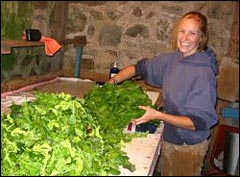Salad greens thrive in the fall; they love brisk, cool nights and mild, sunny afternoons.

Meet your greens.
Photo: iStockphoto
Here in western North Carolina, members of my farm’s CSA (community-supported agriculture) program are enjoying salad mixes that include spicy arugula, mizuna, and purple Osaka leaves, along with bitter endive, earthy shinginku — and yes, even spinach.
Nationwide, though, not many consumers are taking pleasure in fall’s bounty. If the recent E. coli-tainted spinach scare wasn’t enough, a new one — this one involving lettuce — has reared up. California’s Salinas Valley, that national epicenter of industrial salad-greens production, has been implicated yet again, for at least the 10th time in a decade.
Do-gooders have fixed on a solution to this recurring problem: more regulation.
Sens. Charles Schumer (D-N.Y.), Hillary Clinton (D-N.Y.), and Richard Durbin (D-Ill.) have rolled out a bill that would subject raw-vegetable production to a regulatory regime similar to the one governing meat. Their proposal would create a unified Food Safety Administration, combining under one umbrella the USDA’s jurisdiction over meat and poultry processing with the FDA’s over vegetable production. The idea makes eminent sense — if you’re committed to preserving the industrial food system.
If we insist on producing pork on, say, 50,000-swine confinement “farms,” then by all means let’s demand that slaughterhouses meet rigorous federal standards, and subject them to the regular gaze of clipboard-toting bureaucrats. Likewise, if one three-county area of California is going to produce something like half of the nation’s spinach — with most of the rest of production clustered in Arizona — then it’s surely prudent to ramp up regulation of raw-vegetable processing facilities.
Yet there are severe costs to relying on a heavy government hand to ensure a reasonable level of food safety. Inspectors are adept at enforcing rules, and less so at making obvious distinctions.
Small-scale livestock farmers, for example, must leap formidable hurdles to get meat to nearby consumers. A 2003 article from, of all places, the right-wing National Review documents that plight. The USDA requires that animals be killed at USDA-approved slaughterhouses, but the number of such facilities has plunged as the meat industry consolidates. One poultry farmer in Tennessee, looking to sell meat to nearby residents, told the Review that her state had not one single USDA-approved slaughterhouse appropriate for small producers. She considered building her own, but reckoned that meeting the requirements aimed at larger operations would turn a $20,000 investment into a $150,000 debacle.
In my area of western North Carolina, many valleys and some of the gentler hillsides are lined with cows munching grass, and there’s growing demand for local, pasture-raised meat. Ideally, our farmers would sell meat to their neighbors. Yet it’s nearly impossible to buy a local steak; the local branch of the health-food supermarket chain Earth Fare sells grass-fed beef from Montana. That’s because there’s no USDA-approved slaughterhouse reasonably nearby. Thus most farmers ship their cows to corporate-owned Kansas feedlots, where they’re packed into pens and stuffed with corn, their meat to be distributed to supermarkets across the nation.
That means that federal regulations are essentially placing obstacles between local consumers and farmers, and favoring an environmentally ruinous, nutritionally suspect model (corn-fed beef shipped long distances) over a much more benign one (grass-fed beef consumed locally).
Will a similar system now govern raw-vegetable marketing?
I sure hope not. The farm where I work has been selling specialty salad greens to restaurants for 30 years, and directly to consumers for three years through our CSA and farmers’ market. We’re extremely careful in the field and the washhouse, not least because we know that if something goes wrong with our product, there will be no mystery about where it came from.

Washed locally: the washhouse at Maverick Farms.
Photo: Tom Philpott
Imagine if our 150-square-foot washhouse had to meet standards applicable to gargantuan wash factories run by the likes of Earthbound Farm — whose products, the company boasts, are available “in 74 percent of all supermarkets and can be found in every major city in the United States.”
Imagine if, like small-scale cattle farmers, we had to ship our produce 70 or 80 miles away to be washed and packed at a “USDA-approved” plant.
Such scenarios seem unlikely, given the surging popularity of farmers’ markets and CSAs. A critical mass of consumers has grown accustomed to buying vegetables directly from nearby farmers. It seems to me that their outrage would be enough to quash heavy-handed federal attempts to erect barriers between vegetable farmers and consumers.
Meanwhile, though, rhetoric presenting raw salad greens as a menace equal to that of meat proliferates. A recent New York Times article reports that the FDA is considering regulations for vegetables “modeled on the Hazard Analysis Critical Control Point system used in meat, poultry, fish, and egg processing plants in which preventive controls minimize hazards in food.”
The high-profile Center for Science in the Public Interest — which I once chided as “one of those do-gooder groups that lectures the public on the importance of eating one’s spinach, without questioning whether that spinach was doused with pesticides or trucked cross-country from a factory farm” — supports that idea. “We need mandatory standards, enforced across the system,” a CSPI official told the Times.
I have what might be a better idea. Rather than rely on the federal government to keep your spinach safe, get thee to the farmers’ market and meet your area farmers. Fall is not only the season for salad greens; it’s also when farmers are floating shares in the next year’s CSA. Buy one, and it’s doubtful that you’ll ever have to regard a handful of fresh greens with the caution required of, say, a raw pork chop. CSAs can by pricy compared to shopping at the supermarket, but many offer low-income sliding scales or work-exchange options — possibly because farmers tend to be low-income themselves, and thus understand how important price can be.
Better still, plant your own bed of greens — if not in a yard, then in a big pot or a community garden. We get most of our seeds from Fedco and Johnny’s, which provide all manner of delicious greens varieties to small specialty growers as well as home gardeners.
These options promise more than just safe salad greens. You’ll be taking a measure of control over — and responsibility for — food production in a society of passive food consumers. And you’ll be gaining food-growing knowledge in a system predicated on consumer ignorance.
Need I add that there’s more flavor in one leaf plucked from one’s own garden — or from the farm down the road — than in a whole load of greens trucked in from across the continent?


